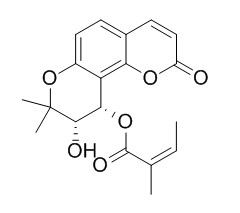d-Laserpitin
Reference standards.
Inquire / Order:
manager@chemfaces.com
Technical Inquiries:
service@chemfaces.com
Tel:
+86-27-84237783
Fax:
+86-27-84254680
Address:
1 Building, No. 83, CheCheng Rd., Wuhan Economic and Technological Development Zone, Wuhan, Hubei 430056, PRC
Providing storage is as stated on the product vial and the vial is kept tightly sealed, the product can be stored for up to
24 months(2-8C).
Wherever possible, you should prepare and use solutions on the same day. However, if you need to make up stock solutions in advance, we recommend that you store the solution as aliquots in tightly sealed vials at -20C. Generally, these will be useable for up to two weeks. Before use, and prior to opening the vial we recommend that you allow your product to equilibrate to room temperature for at least 1 hour.
Need more advice on solubility, usage and handling? Please email to: service@chemfaces.com
The packaging of the product may have turned upside down during transportation, resulting in the natural compounds adhering to the neck or cap of the vial. take the vial out of its packaging and gently shake to let the compounds fall to the bottom of the vial. for liquid products, centrifuge at 200-500 RPM to gather the liquid at the bottom of the vial. try to avoid loss or contamination during handling.
Bioorg Chem.2024, 145:107184.
Cytotechnology.2017, 69(5):765-773
Pharmaceutics.2021, 13(7):1028.
J of Food Quality2020, 8851285.
Environ Toxicol.2023, tox.23999.
Pharmaceuticals (Basel).2024, 17(3):341.
Enzyme Microb Technol.2022, 161:110111.
J Ethnopharmacol.2020, 269:113752.
Front Endocrinol (Lausanne).2023, 14:1138676.
Environ Toxicol.2023, 38(7):1641-1650.
Related and Featured Products
J Chromatogr A. 2013 Oct 4;1310:66-73.
Application of stepwise gradients in counter-current chromatography: a rapid and economical strategy for the one-step separation of eight coumarins from Seseli resinosum.[Pubmed:
23992840]
The targeted purification of compounds with a broad polarity range from traditional medicinal plants is a big challenge for counter-current chromatography (CCC). Gradient elution was introduced in CCC to address this problem. However, once a suitable solvent system is selected, the separation process requires optimization of operational parameters.
METHODS AND RESULTS:
The present study was conducted to optimize various operational parameters to integrate the flow rate and solvent gradients for the rapid isolation of eight coumarins from Seseli resinosum in a single run. An increase in the system temperature from 15°C to 35°C increased the stationary phase retention and solubility of the sample, whereas the operation time and viscosity of the system were decreased. The high purity of each compound was ensured by collecting the fractions from the main peaks while all the shoulder peaks were mixed and separated under the same conditions with semi-preparative CCC. GC-FID was used to analyze the components of each phase, which was prepared without presaturation to save the time and solvent consumption. Finally, eight coumarins were purified, including (1) d-Laserpitin, (2) (3'S,4'S)-3'-angeloyloxy-4'-hydroxy-3',4'-dihydroseselin, (3) (+)-samidin, (4) (3'S,4'S)-3'-acetoxy-4'-angeloyloxy-3',4'-dihydroseselin, (5) deltoin (6), calipteryxin, (7) (3'S,4'S)-3',4'-disenecioyloxy-3',4'-dihydroseselin, and (8) (-)-anomalin.
CONCLUSIONS:
The present technique has successfully accomplished the goal of one-step separation of these compounds with high purity and recovery in an economic and time efficient manner.
Z Naturforsch C. 2009 Jan-Feb;64(1-2):56-62.
Anti-inflammatory and antinociceptive activity of coumarins from Seseli gummiferum subsp. corymbosum (Apiaceae).[Pubmed:
19323267]
n-Hexane and ethyl acetate extracts as well as coumarin derivatives obtained from the n-hexane extract of the aerial parts of Seseli gummiferum Pall. ex Sm. subsp. corymbosum (Boiss. & Heldr.) P.H. Davis (Apiaceae) were evaluated in vivo for their anti-inflammatory and antinociceptive activities.
METHODS AND RESULTS:
The n-hexane and ethyl acetate extracts of the species were shown to possess significant inhibitory activity against the carrageenan-induced hind paw edema and p-benzoquinone-induced writhing models in mice. Among the isolated coumarin derivatives; (-)-(3'S,4'S)-3'-acetoxy-4'-isovaleryloxy-3',4'-dihydroseselin (1), (-)-(3'S,4'S)-3'-acetoxy-4'-angeloyloxy-3',4'-dihydroseselin (2), (+)-(3'S,4'S)-3'-hydroxy-4'-angeloyloxy-3',4'-dihydroseselin (d-Laserpitin) (3), (-)-(3'S,4'S)-3'-angeloyloxy-4'-hydroxy-3',4'-dihydroseselin (4), and osthole (5), only the 3'-acetoxy derivatives 1 and 2 were found to possess potent antinociceptive and anti-inflammatory activities, per os, without inducing any apparent acute toxicity as well as gastric damage, while all other compounds and extracts were found to be ineffective in the TPA-induced mouse ear edema model assay.



